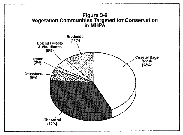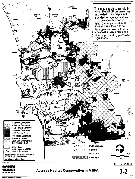MSCP Conservation Plan
Multi-Habitat Planning Area (MHPA)

The process of designing the MSCP preserve incorporated the goals of preserving as much of the core biological resource areas and linkages as possible, maximizing the inclusion of public lands and lands already conserved as open space, and creating an affordable preserve with the equitable sharing of costs. The participating jurisdictions and special districts cooperatively designed a Multi-Habitat Planning Area (MHPA), in partnership with the wildlife agencies (USFWS and CDFG), property owners, and representatives of the development interests and environmental groups. The MHPA is the area within which the permanent MSCP preserve will be assembled and managed for its biological resources. Public acquisition of private lands from willing sellers will be focused within the MHPA.
The MHPA is defined in some areas by mapped boundaries and in others by quantitative targets for conservation of vegetation communities and by goals and criteria for preserve design. The jurisdictions and special districts prepared subarea plans and defined boundaries of their portions of the MHPA based on common objectives and criteria, but using different methods of implementation. The resulting conservation of the subarea plans is summarized in Figure 3-2. The MHPA includes property set aside as mitigation for major development projects as a result of negotiations, habitat designated as open space in general plans, and areas already preserved for their biological resources. The remainder are areas within which the ultimate preserve will be sited.
Habitats Conserved
The MSCP Plan targets 171,917 acres of vacant land within the MHPA for conservation, including over half of all natural lands in the MSCP study area (167,667 acres) and 4,250 acres of other vacant lands that contribute to preserve design. The MHPA conserves 62% of all coastal sage scrub and important portions of all vegetation communities in the study area. This conservation is focused in the most biologically important areas, with nearly three-fourths (73%) of the core biological resource areas and linkages conserved in the MHPA. Table 3-3 and Figure 3-6 summarize the amount of each vegetation community targeted for conservation within the MHPA. Each subarea plan contributing to the total describes a process for allowing development outside the preserve to be mitigated by conservation inside the preserve.
Figure 3-6, Vegetation Communities Targeted
for Conservation in MHPA
View Larger Image
This plan targets 7,591 more acres for conservation than the Draft MSCP Plan, which targeted 164,326 acres. The difference is attributed to several factors: the acreage of public lands targeted for conservation in the MHPA increased by about 10,000 acres; the City of San Diego now targets 4,250 acres of disturbed and agricultural lands to meet preserve configuration needs (however, agriculture is not precluded in the preserve); and the study area has expanded by about 1,050 acres. The acreage of private lands targeted for conservation decreased by about 2,400 acres.
Covered Species
Based on the MHPA preserve configuration, vegetation community conservation targets, and implementation of habitat management plans, 85 species will be adequately conserved and "covered" by this plan. The County of San Diego and cities of San Diego, Poway, and Chula Vista must have approved subarea plans and implementing agreements before take of all 85 species is authorized for all participants. The participating local agencies will receive take authorizations from the federal and state agencies to directly impact or "take" these 85 species, in accordance with approved subarea plans and implementing agreements. The covered species include species listed as endangered or threatened as well as currently unlisted species:
Table 3-3
| Protection Status | Plants | Animals | Total |
|---|---|---|---|
| Federally listed* | 5 | 12 | 17 |
| State listed** | 13 | 2 | 15 |
| Federally proposed | 3 | 1 | 4 |
| Federal candidates (C1 and former C2) | 24 | 12 | 36 |
| Other*** | 1 | 12 | 13 |
| Total | 46 | 39 | 85 |
*May also be state listed.
**Includes 8 plants proposed for federal listing.
***State species of special concern, habitat indicator species, and species important to preserve design.
If, in the future, a covered but unlisted species becomes listed as endangered or threatened, the take authorization will become effective concurrent with its listing.
Narrow Endemic Species. Some native species, primarily plants with restricted geographic distributions, soil affinities, and/or habitats, are referred to as "narrow endemic species." For vernal pools and identified narrow endemic species, the jurisdictions will specify measures in their subarea plans to ensure that impacts to these resources are avoided to the maximum extent practicable.
Uncovered Species
The plan also includes provisions for adding uncovered species to the covered species list. If a species not on the covered species list is proposed for listing, the wildlife agencies will determine if additional conservation measures are needed to adequately protect the species. If additional measures are needed, management practices and enhancement opportunities and reallocation of public acquisition funds will be used provided that covered species are not adversely affected. If these options are not adequate, preference will be given by the wildlife agencies to additional measures that do not require additional mitigation or dedication of land. The wildlife agencies have also agreed to provide additional habitat-based assurances for uncovered species by classifying certain vegetation communities as "significantly" and/or "sufficiently conserved" by the MSCP, as described in the MSCP Plan and Model Implementing Agreement.
Figure 3-2, Average Habitat Conservation in MHPA
View Larger Image
"Vegetation Community Acres Targeted for Conservation Within Multi-Habitat Planning Area"



